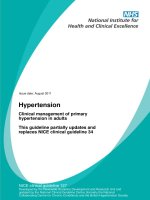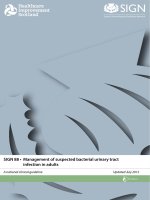Clinical management of hypophosphatemia induced post parturient hemoglobinuria in a buffalo
Bạn đang xem bản rút gọn của tài liệu. Xem và tải ngay bản đầy đủ của tài liệu tại đây (277.57 KB, 4 trang )
Int.J.Curr.Microbiol.App.Sci (2020) 9(7): 3132-3135
International Journal of Current Microbiology and Applied Sciences
ISSN: 2319-7706 Volume 9 Number 7 (2020)
Journal homepage:
Case Study
/>
Clinical Management of Hypophosphatemia Induced Post Parturient
Hemoglobinuria in a Buffalo
R.S. Kathiravan1* and G. Shanmuga Priya2
1
Farm Manager, Directorate of Centre for Animal Health Studies,
TANUVAS, Chennai- 600051, India
2
Veterinarian, Centre for Laboratory Animal Technology and Research, Sathyabama Institute
of Science and Technology, Shollinganallur, Chennai – 600119, India
*Corresponding author
ABSTRACT
Keywords
Hemoglobinuria ,
Hypophosphatemia,
Hemolysis
Article Info
Accepted:
22 June 2020
Available Online:
10 July 2020
A Female Buffalo was presented with hemoglobinuria and reduced milk
yield with history of calving before one month. The buffalo was diagnosed
to have hypophosphatemia through serum biochemistry and treated with
phosphorus and calcium supplements and found better improvement over 5
days of treatment. Clinical advises were given to the animal owner and the
buffalo recovered uneventfully.
Introduction
Chronic phosphorus deficiency is commonly
caused by inadequate feed intake or
inadequate phosphorus content in the ration
over an extended time and also in grazing
animals in arid regions with low phosphorus
content in soil. The sudden onset of
phosphorus losses through the mammary
gland at the onset of lactation and the
decreased feed intake around parturition are
believed to be the major contributors to
postparturient hypophosphatemia of dairy
buffalo (Cohrs and Grünberg, 2018).
Hypophosphatemia in dairy buffalo is thought
to be associated with an increased risk of
disease and impaired productivity particularly
in
early
lactation.
Postparturient
haemoglobinuria (PPHb) is a clinical
syndrome of bovines characterized by
intravascular haemolysis, haemoglobinuria
and anemia (Bhat, 2010; Mac Williams et al.,
1982). The condition is commonly noticed in
third to sixth lactation of dairy animals
(Radostitis et al., 2000) during the period
from calving to fifth week of postpartum
(MacWilliams et al., 1982). The etiology of
PPHb
is
believed
to
involve
hypophosphataemia associated to primary
dietary deficiency (Chugh et al., 1998;
3132
Int.J.Curr.Microbiol.App.Sci (2020) 9(7): 3132-3135
Samad, 1997). The present case report
explains the diagnosis and successful
treatment of PPHb in a 6 year old buffalo.
History
A 6 Years old female buffalo weighing
around 300 Kg was presented in Thangam
Memorial Trust Hospital, Tirupur with the
condition of coffee colored urine, partial
feeding for past three days, reduced milk
yield from 3.5 lit to 1.5 lit and calved one
month back. The same episode was reported
during last calving and treated by local
veterinarian.
Diagnosis
On clinical examination, the buffalo had high
temperature 39.8⁰ C, hemoglobinuria (Fig. 1),
swollen lymph nodes, tachycardia, pale
mucous membrane, polypnea-38/minute, high
pulse rate-78/min and doughy rumen with
reduced motility. Urine sample was tested
positive for glucose and bile salts and the
supernatant remains in dark red color on
centrifugation. Blood sample had reduced
Hemoglobin-4.5g/dl,
PCV-16%,RBC2.5x106ml. The serum biochemistry reveals
hypophosphatemia- 1.9 mg/dl and negative
for hemoprotozoa.
Treatment
The animal was treated with Inj.
Oxytetracycline - 60 ml, Inj. Normal saline 1000 ml intravenously, Inj. Zobid-M - 10 ml
and Inj. Tribivet -10 ml intramuscularly in
first day.
Treatment repeated for 4 days along with Inj.
Alphos - 20 ml, Calcium borogluconate - 450
ml and Inj. Ringers lactate - 1000 ml
intravenously, Inj. Iron sorbital (Feritas) - 6
ml intra muscularly and bolus. Styphon - 8
boli (2-0-2). Clinical status of the animal
improved on 5th day of treatment with
improved serum phosphorus level of 4 mg/dl,
Hemoglobin - 7.1g/dl, PCV - 26%, RBC 4.5x106 ml and urine colored changed to light
yellow.
Fig.1 Clinical symptom of hemoglobinuria in buffalo
Acute phosphorus losses associated with
hypophosphatemia are a well-recognized
problem in high-yielding dairy cows at the
onset of lactation. Phosphorus depletion can
also result from chronic renal tubular disease
due to impaired renal
phosphorus.
reabsorption
of
Chugh et al., (1998) reported the severe
hypophosphataemia leads to post-parturient
3133
Int.J.Curr.Microbiol.App.Sci (2020) 9(7): 3132-3135
haemoglobinuria in buffaloes. The initial
serum phosphorus level in the present
reported case was 1.8 mg/dL. This is lower
than the normal range (2 mg/dL) indicating
phosphorus deficiency in bovines (Samad,
1997).
Increased
fragility
associated
with
hypophosphatemia is suggested to subject
erythrocytes to destruction by circulating
oxidants (Jubb et al., 1990). Phosphorus
deficiency is usually primary i.e. involving an
absolute deficiency in the diet (Radostitis et
al., 2000).
Symptoms includes pale mucous membrane,
anemia, increased heart rate ,increased pulse
rate, dyspnea, difficult in defecation,
hemoglobinuria, decreased serum phosphorus.
Young animals grow slowly, develop rickets,
and tend to have a rough hair coat, whereas
adult animals in early stages may become
lethargic, anorectic, and lose weight (MSD
vet manual). The phosphorus deficiency,
leading to hypophosphatemia, may be a
mechanism of post parturient and related
syndromes of haemoglobinuria by decreasing
red cell glycolysis and resultant ATP
synthesis. Subnormal concentrations of ATP
would predispose red cells to altered structure
and function, a loss of normal deformability,
and an increase in fragility and haemolysis
with resultant haemoglobinuria (Ogawa et al.,
1987) Chronic phosphorus depletion and
hypophosphatemia is most effectively treated
by providing sufficient amounts of feed with
adequate phosphorus content. Intravenous
administration of phosphorus-containing
solutions is the most appropriate approach. In
cattle, rapid administration of sodium
phosphate salt solutions is commonly
practiced. Mono or dibasic phosphate salts
(either Na2HPO4 or NaH2PO4) infused IV
rapidly increase the serum Pi concentration.
Tribasic phosphate (Na3PO4) is a caustic
detergent that cannot be used under any
circumstances for PO or IV phosphorus
supplementation. (MSD vet manual).
In conclusion a single injection of acid
sodium phosphate 20 ml intravenous route is
giving correction for acute hyphophataemia in
Buffaloes. The treatment has a rapid onset of
action and a sustained effect. Severe
hyphophosphataemia condition is an indicator
for intravenous rather than oral phosphorus
supplementation.
Prevention
of
hyphophosphataemia is the best therapy. So
these treatments should be used only if
indicated and carefully monitored.
References
Bhat, P.N. 2010. Buffalo Production. Studium
Press (India) Pvt. Ltd, 302- 304 Chugh,
S.K., R.M. Bhardwaj and M.M. Mata.
1998. Lowered antioxidant status of red
blood
cells
in
post-parturient
haemoglobinuria of buffaloes. Vet. Res.
Commun., 6: 383-388.
Chugh, S.K., R.M. Bhardwaj and M.M. Mata.
1998. Lowered antioxidant status of red
blood
cells
in
post-parturient
haemoglobinuria of buffaloes. Vet. Res.
Commun., 6: 383-388.
Cohrs, I. and Grünberg, W. 2018. Suitability
of oral administration of monosodium
phosphate, disodium phosphate, and
magnesium phosphate for the rapid
correction of hypophosphatemia in
cattle. J Vet Intern Med. 32(3):12531258.
Mac Williams P.S., G.P. Searcy and J.E.C.
Bellamy. 1982. Bovine post-parturient
haemoglobinuria. Canadian Veterinary
Journal, 23: 309.
MSD vet manual.2014.Walter Gruenberg ,
MedVet,
DECAR,
DECBHM,
University of Veterinary Medicine
Hannover, Foundation. Apr 2014.
Ogawa., Kobayashi, K., Yoshiura, N. and
Mukai, J. 1987. Bovine Postparturient
3134
Int.J.Curr.Microbiol.App.Sci (2020) 9(7): 3132-3135
Hemoglobinemia: Hypophosphatemia
and Metabolic Disorder in Red blood
cells. Am. J. Vet. Res. 48; 1300-3.
Radostits, O. M., C.C. Gay, K. W. Hinchcliff
and
P.
D.
Constable.
2000.
VETERINARY
MEDICINEA;
textbook of the diseases of cattle,
horses, sheep, pigs and goats. Saunders
Elsevier, Edinburgh London New York
Oxford Philadelphia St Louis Sydney
Toronto, 1700 – 1793p.
Samad, A. 1997. Host and environmental
factors
associated
withphosphorus
deficiency
hemaoglobinurea
in
buffaloes. Buffalo j, 13: 385 – 395.
Wang, X.L., C.H. Gallagher, T.J. McClure,
V.E. Reeve and P.J. Canfield. 1985.
Bovine postparturient haemoglobinuria:
effect of inorganic phosphate on red cell
metabolism. Res Vet Sci, 39(3): 333339.
How to cite this article:
Kathiravan, R.S. and Shanmuga Priya, G. 2020. Clinical Management of Hypophosphatemia
Induced Post Parturient Hemoglobinuria in a Buffalo. Int.J.Curr.Microbiol.App.Sci. 9(07):
3132-3135. doi: />
3135









